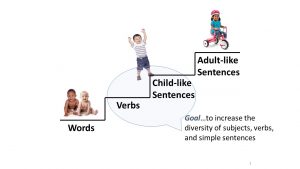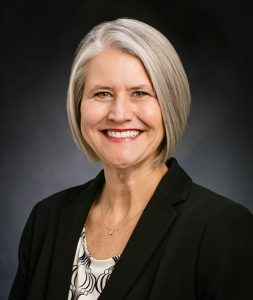The Sentence-Focused Framework (SFF) was developed to focus clinical attention on young children’s ability to produce diverse sentences. For children developing typically, sentences become more diverse and complex between the ages of 2 and 3. For children at-risk for developmental language disorder (DLD) and other neurodevelopmental disorders, the transition from words to diverse sentences starts later and takes much longer. Some children may even say lots of different words, but their sentences sound similar — I want that. I want baby. I want baby out.
The Sentence-Focused Framework is conceptualized as a series of four developmental steps: words, verbs, child-like sentences, and adult sentences (see below). The first two steps focus on building a core vocabulary of content-rich words. The last two steps focus on building sentence structure. The framework is intended to bridge early vocabulary and grammar interventions for toddlers and preschoolers with language disorders by emphasizing how verbs are related to sentence structure, and how later-developing aspects of grammar are related to diverse sentence structure.
We’ll use this blog to explain ways to assess children’s progress through the developmental sequence — words, verbs, child-like sentence s, simple, adult sentences. We’ll also provide recommendations about sentence-focused treatment targets that can help young children produce diverse sentences and point you to resources on this website and elsewhere. Although the examples are for English grammar, the general principles can be adapted for other languages too.
s, simple, adult sentences. We’ll also provide recommendations about sentence-focused treatment targets that can help young children produce diverse sentences and point you to resources on this website and elsewhere. Although the examples are for English grammar, the general principles can be adapted for other languages too.
In the next blog post, we’ll talk about the first two steps — Words & Verbs — and how a diverse vocabulary made up of object names (nouns), location words (prepositions), descriptive words (adjectives) and action words (verbs) support children’s sentence development.
Photo Credits: Baby1 by Unknown Author is licensed under CC BY / Baby2 by Unknown Author is licensed under CC BY-NC / Little Boy is from publicdomainpictures.net./ Little Girl by Unknown Author is licensed under CC BY-NC


